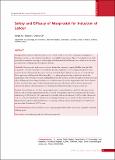Please use this identifier to cite or link to this item:
https://hdl.handle.net/20.500.14356/2008| Title: | Safety and Efficacy of Misoprostol for Induction of Labour |
| Authors: | Chawla, C D Dongol, A S Shakya, S |
| Citation: | ChawlaC. D., DongolA. S., & ShakyaS. (2010). Safety and Efficacy of Misoprostol for Induction of Labour. Journal of Nepal Health Research Council. https://doi.org/10.33314/jnhrc.v0i0.219 |
| Issue Date: | 2010 |
| Publisher: | Nepal Health Research Council |
| Article Type: | Original Article |
| Keywords: | Cervical ripening Induction of labour Misoprostol |
| Series/Report no.: | April, 2010;219 |
| Abstract: | Abstract Background: Induction of labour is widely carried over the world in cases where continuation of pregnancy is hazardous to mother or fetus. Varieties of techniques are available for induction of labour. Prostaglandin is one of the most effective means for achieving cervical ripening and induction of labour. This study was carried out to see safety and effectiveness of Misoprostol for induction of labour.  Methods: This prospective study was carried out at Kathmandu University Hospital, Dhulikhel from Jan 2008 to Aug 2009. A  total of 70 patients were included in this study. All patients received 50µg of Misoprostol in the posterior fornix with maximum dose up to 3 doses at interval of 6 hours. Bishops scoring was reviewed each time before application of Misoprostol. When favourable cervix along with good uterine contraction is noted then augmentation with Oxytocinon was done holding Misoprostol. The measures used for the analysis of effectiveness and safety of Misoprostol were change in bishop score, total dose required, need for augmentation, side effects, duration of first, second and third stages of labour, duration from induction till delivery, mode of delivery and neonatal outcome. The primary outcome measures were induction to delivery interval and caesarean section rate.    Results: Out of 70 patients, 21 (30%) required augmentation. Among 70patients, 46 (65%) underwent normal delivery, 6 (8.6%) underwent instrumental delivery and 18 (25%) patients underwent cesarean section for various indications (p=0.00). Total 31 (44%) patients delivered within 10 hours of induction, 16 (22%) within 15hours and 4 (4.7%) took more than18 hours. Duration of second stage of labour was also found to be shortened with use of Misoprostol for induction of labour. Duration of second stage of labour was less than 30 minutes in 42 (60%) cases and more than 30 minutes in 9 (17%) cases. Conclusions: Misoprostol is an effective cervical ripening agent with favorable outcome and comparable with other inducing agents.                     Key words: cervical ripening, induction of labour, misoprostol. |
| Description: | Original Article |
| URI: | http://103.69.126.140:8080/handle/20.500.14356/2008 |
| ISSN: | Print ISSN: 1727-5482; Online ISSN: 1999-6217 |
| Appears in Collections: | Vol 8 No 1 Issue 16 April 2010 |
Files in This Item:
| File | Description | Size | Format | |
|---|---|---|---|---|
| 219-Article Text-217-1-10-20130822.pdf | Fulltext Download | 182.52 kB | Adobe PDF |  View/Open |
Items in DSpace are protected by copyright, with all rights reserved, unless otherwise indicated.
